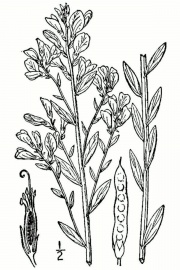Difference between revisions of "Dyer's broom"
| (4 intermediate revisions by 4 users not shown) | |||
| Line 1: | Line 1: | ||
| − | [[File:genistapd1.jpg|thumb|Dyer's greenweed | + | [[File:genistapd1.jpg|thumb|Dyer's greenweed ''Genista tinctoria'']] |
| − | |||
| − | ''Genista tinctoria'']] | ||
== Description == | == Description == | ||
| Line 14: | Line 12: | ||
Genistein is soluble in water, ethanol, ether and alkalis. | Genistein is soluble in water, ethanol, ether and alkalis. | ||
| − | == | + | == Risks == |
Genistein decolorizes in acids. | Genistein decolorizes in acids. | ||
| − | == | + | ==Resources and Citations== |
| − | + | * J.Hofenk-de Graaf, ''Natural Dyestuffs: Origin, Chemical Constitution, Identification''. Central Research Laboratory for Objects of Art and Science, Amsterdam, September 1969. | |
| − | + | * Analytical strategies for natural dyestuffs in cultural heritage objects - EU-ARTECH European research project - http://www.organic-colorants.org | |
* R.J. Adrosko, ''Natural Dyes in the United States'', Smithsonian Institution Press, Washington, DC, 1968 | * R.J. Adrosko, ''Natural Dyes in the United States'', Smithsonian Institution Press, Washington, DC, 1968 | ||
Latest revision as of 11:53, 27 July 2022
Description
A yellow dye obtained from the flowers, leaves and branches of a small shrub (Genista tinctoria) native to Europe and Asia. Dyer's broom was used as a yellow dye on Wool since prehistoric times. Up to the 17th century, dyer's broom was one of three yellow fabric dyes used Europe. The primary colorant in dyer's broom is genistein. It produces a strong yellow color with an alum mordant. Often woad was overdyed on the dyer's broom to produce a yellowish-greenish color known as Kendal green. In the United States, the name dyer's broom has also been used for the Broomsedge plant.
Synonyms and Related Terms
Genista tinctoria; Natural Yellow 2; dyer's weed; genêt des teinturiers (Fr.); Farberginster (Deut.); genestrella (It.); retama de tintorero (Esp.); retama de tines (Esp.); ververs brem (Ned.); dyer's greenweed; woodwax; woodwaxen; genestrolle; woadwaxen; greenweed; grassing weed; broomsedge genistein; kendal green; Kendal green
Other Properties
Genistein is soluble in water, ethanol, ether and alkalis.
Risks
Genistein decolorizes in acids.
Resources and Citations
- J.Hofenk-de Graaf, Natural Dyestuffs: Origin, Chemical Constitution, Identification. Central Research Laboratory for Objects of Art and Science, Amsterdam, September 1969.
- Analytical strategies for natural dyestuffs in cultural heritage objects - EU-ARTECH European research project - http://www.organic-colorants.org
- R.J. Adrosko, Natural Dyes in the United States, Smithsonian Institution Press, Washington, DC, 1968
- S. Grierson, The Colour Cauldron, Oliver McPherson Ltd., 1986
- Helmut Schweppe, Schweppe color collection index and information book
- John and Margaret Cannon, Dye Plants and Dyeing, Herbert Press, London, 1994
- The Dictionary of Art, Grove's Dictionaries Inc., New York, 1996 Comment: "Pigments"
- Colour Index International online at www.colour-index.org
- J. Thornton, 'The Use of Dyes and Colored Varnishes in Wood Polychromy', Painted Wood: History and Conservation, The Getty Conservation Insitute, Los Angeles, 1998
